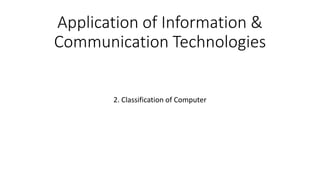Application of ICT 2ndLec classification of computers.pptx
•Download as PPTX, PDF•
0 likes•2 views
2nd lecture ICT
Report
Share
Report
Share

Recommended
More Related Content
Similar to Application of ICT 2ndLec classification of computers.pptx
Similar to Application of ICT 2ndLec classification of computers.pptx (20)
Fundamentals of computer and information system(unit 1)

Fundamentals of computer and information system(unit 1)
Recently uploaded
This presentation was provided by William Mattingly of the Smithsonian Institution, during the fourth segment of the NISO training series "AI & Prompt Design." Session Four: Structured Data and Assistants, was held on April 25, 2024.Mattingly "AI & Prompt Design: Structured Data, Assistants, & RAG"

Mattingly "AI & Prompt Design: Structured Data, Assistants, & RAG"National Information Standards Organization (NISO)
Recently uploaded (20)
SECOND SEMESTER TOPIC COVERAGE SY 2023-2024 Trends, Networks, and Critical Th...

SECOND SEMESTER TOPIC COVERAGE SY 2023-2024 Trends, Networks, and Critical Th...
Unit-IV; Professional Sales Representative (PSR).pptx

Unit-IV; Professional Sales Representative (PSR).pptx
Z Score,T Score, Percential Rank and Box Plot Graph

Z Score,T Score, Percential Rank and Box Plot Graph
Mixin Classes in Odoo 17 How to Extend Models Using Mixin Classes

Mixin Classes in Odoo 17 How to Extend Models Using Mixin Classes
Unit-V; Pricing (Pharma Marketing Management).pptx

Unit-V; Pricing (Pharma Marketing Management).pptx
Ecological Succession. ( ECOSYSTEM, B. Pharmacy, 1st Year, Sem-II, Environmen...

Ecological Succession. ( ECOSYSTEM, B. Pharmacy, 1st Year, Sem-II, Environmen...
Beyond the EU: DORA and NIS 2 Directive's Global Impact

Beyond the EU: DORA and NIS 2 Directive's Global Impact
Web & Social Media Analytics Previous Year Question Paper.pdf

Web & Social Media Analytics Previous Year Question Paper.pdf
Mattingly "AI & Prompt Design: Structured Data, Assistants, & RAG"

Mattingly "AI & Prompt Design: Structured Data, Assistants, & RAG"
Measures of Dispersion and Variability: Range, QD, AD and SD

Measures of Dispersion and Variability: Range, QD, AD and SD
Application of ICT 2ndLec classification of computers.pptx
- 1. Application of Information & Communication Technologies 2. Classification of Computer
- 2. Classification of Computers • Computer are classified on the bases of size, speed, processing power and price • Computer can be classified into the following categories 1. Personal Computer 2. Mobile Devices 3. Minicomputer 4. Mainframe Computer 5. Supercomputer 6. Embedded Computer
- 3. 1. Personal Computers/Microcomputers • Persona computer is designed to be used by one persona at a time • It consists of a processor, memory and one or more input, output and storage devices • Personal computers are available in different sizes and shapes • Personal computer is commonly used in business, at home and other fields of life
- 4. 1.1 Desktop Computer • Desktop computers are the most common type of personal computer • It is designed in a way that all of its components fit on a desk or table • In one model, the system unit is placed horizontally on the desktop or table and monitor is placed on the system unit • In another model called tower model, both monitor and system unit are placed on the table
- 5. 1.2 Portable Computer • Portable computer is a mobile personal computer that can be carried from one place to another • It has input, output , storage and processing components integrated into a single unit • It can receive power from battery • Different types of portable computers include I. Laptop II. Tablet
- 6. 2. Mobile Devices • A mobile device is a computing device designed to hold in the hand • Mobile devices typically have small screens and some of them have keyboards • Mobile devices can be connected to a large network to exchange data • Popular types of mobile devices are smart phones
- 7. 3. Minicomputers • Minicomputer is typically larger, more powerful and more expensive than personal computer • Minicomputer can serve up to several hundreds connected users at the same time • It can be used in networked environment as server computer • It is normally access by users through a personal compute • Some examples of mini computers are Prime 9955, HP 3000 etc
- 8. 4. Mainframe Computers • Mainframe computer is a large computer designed to serve several thousands connected users at the same time • It is more powerful and expensive as compared to minicomputer • These computers can store large amount of data, information and programs • The user access a mainframe computer through personal computer
- 9. 5. Supercomputers • Supercomputer is the fastest and the most powerful computer • It is biggest in size and more expensive than any other computer • It is used to perform complex tasks • The modern supercomputer consists of thousands of microprocessors • It can process trillions of instructions in one second • Supercomputer is mostly used for weather forecasting, weapon design and atomic research etc
- 10. 6. Embedded Computers • An embedded computer is designed for special purposes • It works as a component in a larger product • These computers are very small and have limited hardware • They perform various functions according to the requirement of the product in which they are embedded • Embedded computers are used in automobiles, robotics and home devices such as security monitoring system